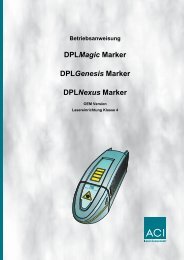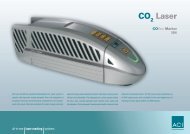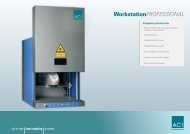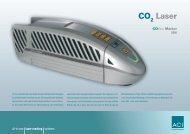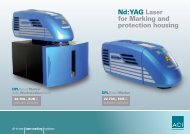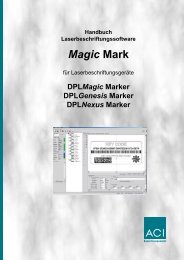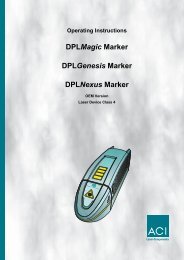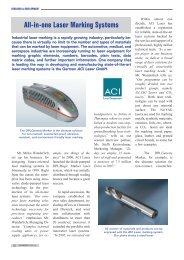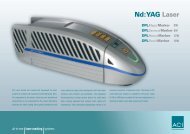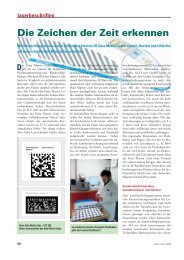Operating Instructions Dplmagic Marker Dplgenesis ... - ACI Laser
Operating Instructions Dplmagic Marker Dplgenesis ... - ACI Laser
Operating Instructions Dplmagic Marker Dplgenesis ... - ACI Laser
You also want an ePaper? Increase the reach of your titles
YUMPU automatically turns print PDFs into web optimized ePapers that Google loves.
Detailed Advanced Information<br />
Temperature stabilisation of<br />
the resonator<br />
The stability of the laser in respect of power and beam quality is<br />
especially important for the reproducibility of inscriptions. The<br />
DPLMagic/Genesis/Nexus <strong>Marker</strong> has therefore been equipped<br />
with temperature stabilisation of the active laser medium. This<br />
guarantees first class marking results even with very different power<br />
settings or even after the laser has been on stand-by for a long time.<br />
The temperature stabilisation of the laser crystal clearly reduced the<br />
formation of the so-called "thermal lens".<br />
This temperature stabilisation is also realised via a thermoelectric<br />
module. As the resonator is very efficient, the module requires<br />
significantly less power. The waste heat is conveyed out by means<br />
of a fan.<br />
13.5 The Materials Science of <strong>Laser</strong> Marking in Brief<br />
The question of whether a material is suitable for laser marking can<br />
generally be answered with yes, provided that it adequately absorbs<br />
the processing wavelength, this is 1064 nm in the case of the<br />
DPLMagic/Genesis/Nexus <strong>Marker</strong>.<br />
Complex interactions take place between the laser beam and the<br />
work piece during the marking procedure.<br />
The workability of a material depends upon the following material<br />
properties, among others:<br />
• chemical composition,<br />
• carbon content,<br />
• spectral absorption,<br />
• thermal conductivity,<br />
• surface condition (dirt, structure, etc.).<br />
The laser beam parameters also play a significant role.<br />
These include:<br />
• wave length,<br />
• pulse frequency,<br />
• pulse energy,<br />
• peak pulse power,<br />
• beam quality,<br />
• focus diameter.<br />
The large number of parameters show that the marking result<br />
depends upon several influencing factors.<br />
The following section is intended to give the user an insight into the<br />
many possibilities for marking by means of a laser beam.<br />
46 <strong>Operating</strong> <strong>Instructions</strong> DPLMagic/Genesis/Nexus <strong>Marker</strong> - 08/2006



